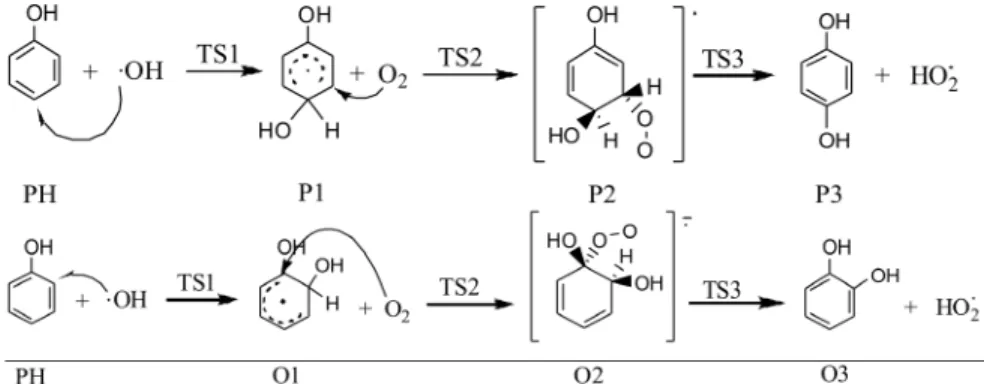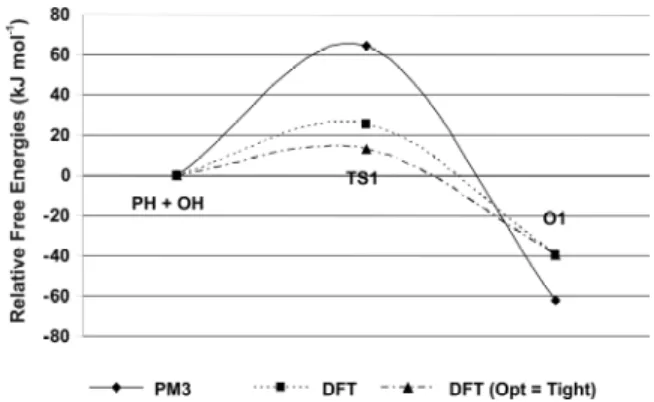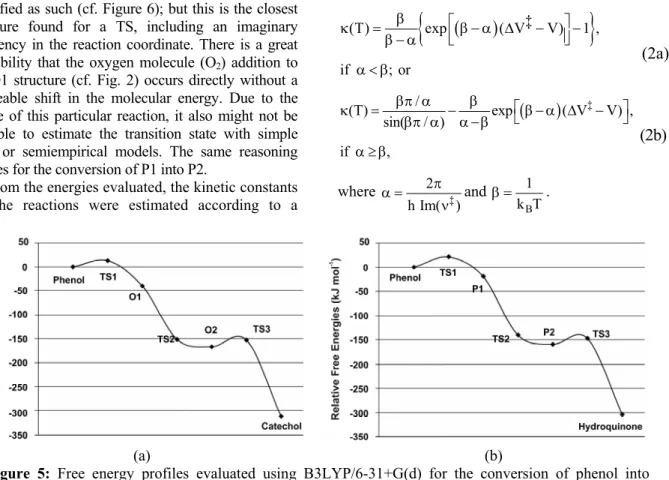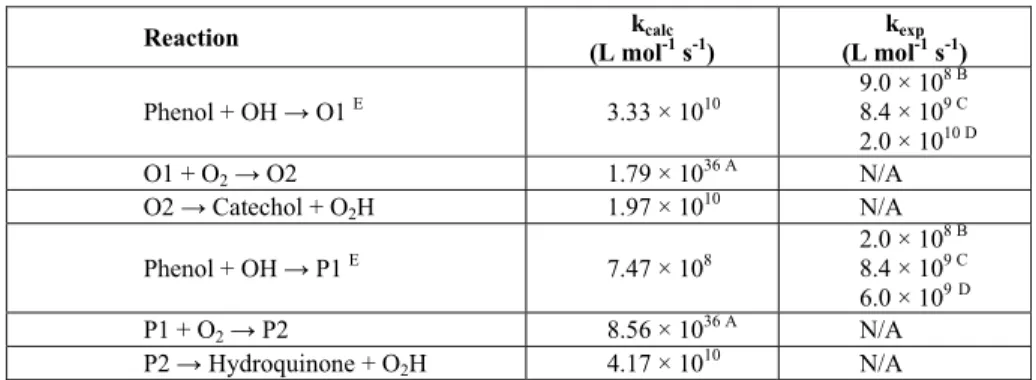ISSN 0104-6632 Printed in Brazil
www.abeq.org.br/bjche
Vol. 29, No. 01, pp. 113 - 120, January - March, 2012
Brazilian Journal
of Chemical
Engineering
ESTIMATING REACTION CONSTANTS BY
AB
INITIO
MOLECULAR MODELING: A STUDY ON
THE OXIDATION OF PHENOL TO CATECHOL
AND HYDROQUINONE IN ADVANCED
OXIDATION PROCESSES
B. Ramos
1*, J. P. S. Farah
2and A. C. S. C. Teixeira
11
Centro de Engenharia de Sistemas Químicos, Departamento de Engenharia Química, Escola Politécnica, Phone: + (55) (11) 3091-2263, Phone: + (55) (11) 2263, Universidade de São Paulo,
Av. Prof. Luciano Gualberto, Travessa 3, 380, CEP: 05508-900, São Paulo - SP, Brazil. E-mail: * bruno.ramos@usp.br; E-mail: acscteix@usp.br
2Departamento de Química Fundamental, Instituto de Química, Universidade de São Paulo,
Phone: + (55) (11) 3091-2056, Av. Prof. Lineu Prestes, 748, CEP: 05508-900, São Paulo - SP, Brazil. E-mail: jpsfarah@usp.br
(Submitted: December 22, 2010 ; Revised: August 17, 2011 ; Accepted: August 28, 2011)
Abstract - Molecular modeling is growing as a research tool in Chemical Engineering studies, as can be seen by a simple research on the latest publications in the field. Molecular investigations retrieve information on properties often accessible only by expensive and time-consuming experimental techniques, such as those involved in the study of radical-based chain reactions. In this work, different quantum chemical techniques were used to study phenol oxidation by hydroxyl radicals in Advanced Oxidation Processes used for wastewater treatment. The results obtained by applying a DFT-based model showed good agreement with experimental values available, as well as qualitative insights into the mechanism of the overall reaction chain. Solvation models were also tried, but were found to be limited for this reaction system within the considered theoretical level without further parameterization.
Keywords: Molecular modeling; Chemical kinetics; Advanced Oxidation Processes.
INTRODUCTION
The applicability of computational chemistry techniques is very well known in the chemical and biochemical sciences. However, considering the amount of published work within the respective research fields, computational chemistry is not yet well exploited for Chemical Engineering purposes, where it could play a very important role, such as in process design and reactor modeling. Indeed, computational chemistry (or molecular modeling, as it is often called) has been recently pointed out as
one of the major fields relating to the progress of Chemical Engineering science (Charpentier, 2007).
course of an Advanced Oxidation Process (AOP). The calculations were carried out both in the gas phase as well as in a simulated aqueous media.
METHODOLOGY
Computational Details
Fundamental aspects of molecular modeling theory and techniques are discussed by Cramer (2004). In the present work, the semiempirical model AM1 (Dewar
et al., 1985) and the DFT functionals B3LYP (Becke, 1993) for thermodynamic studies and B3PW91 (Perdew et al., 1991) for geometry calculations were chosen based upon previous studies and reference databases (Cramer, 2004). Two different implicit solvation models were tested in order to evaluate the impact of solvation on the results obtained: SM5.42R (Li et al., 1999) and PCM (Polarized Continuum Model) (Miertus and Tomasi, 1982).
The calculations were carried out with Gaussian 03 (Frisch et al., 2004) and AMSOL 7.1 (Hawkins et al., 2004). The Steepest Descent algorithm was used to optimize the structures, along with tight convergence criteria. To find the optimum transition state, QST (Quantum Synchronous Transit) approaches were used; both QST2 and QST3 methods were used, depending on the level of theory and the situation. The thermodynamic properties were retrieved for T = 300 K at atmospheric pressure, using the frequency calculations output from the software (cf. Ochterski, 2000). These thermodynamic variables are used to estimate the kinetics, through well-established thermodynamic relationships. The optimized structures were then subjected to new optimization routines under solvation conditions.
All calculations were carried out on a 112 GB RAM and 56 Intel Itanium 2 CPUs SGI Server, at
LCCA/USP (Laboratory for Advanced Scientific Computation of the University of São Paulo).
Reactions
The mechanism of phenol oxidation proposed by Devlin and Harris (1984) includes an initial conversion of phenol into catechol and hydroquinone. Figure 1 highlights the reactions modeled within the studied mechanism in the present work, considering the electrophilic attack promoted by hydroxyl radicals. Although many reaction paths for phenol + ●OH radicals are possible, previous experimental evidence of the authors revealed only traces of the other products, almost negligible compared to the two OH-addition reactions modeled. Besides, the work of Kılıç et al. (2007) has shown a low yield for the reactions other than the ones considered in Figure 1. Therefore, for practical purposes, in the present work only these two reactions were considered.
In Advanced Oxidation Processes, the oxidation reactions are carried out by reactive oxygen species (ROS), such as hydroxyl (●OH) and hydroperoxyl (HO2●) radicals, the superoxide anion-radical (O2●-),
ozone (O3), etc. The radical species are, in most cases,
generated through photochemical processes, which require an extensive database of reaction rates, along with detailed information on the characteristics of the light source (spectra, intensity, nominal power, etc.), absorption bands of the reactants, quantum yields of the photoreactions, among all the necessary parameters for traditional process design. Since most of the reactions occurring in these processes are essentially radical-based (and, therefore, their detailed kinetic study is experimentally complicated and/or cost- and time-prohibitive), molecular modeling is an interesting tool to estimate the thermokinetic parameters involved for Chemical Reaction Engineering studies.
Figure 1: Conversion from phenol (PH) to catechol (O3) or hydroquinone
RESULTS
Molecular Geometry
For all the geometric data reported here, refer to Figure 2.
Figure 2: Molecular structure of phenol.
Phenol is an aromatic compound, consisting of 6 sp2-carbons, bonded to five hydrogen atoms and one hydroxyl group. It has a total of 13 nuclei and 50 electrons, of which 36 belong to valence shells and need to be taken into account in the calculations. The geometric parameters were evaluated with different methods and algorithms for comparison purposes with experimental data (see Table 1).
Table 1: Experimental data for geometrical parameters of the phenol molecule (Lide, 2009).
Bond Lengths (Å) Angle (Degrees)
C-C Ca-O Cb-H Cc-H Cd-H O-H COH 1.397 1.364 1.084 1.076 1.082 0.956 109
Semiempirical, ab-initio and DFT methods were used to evaluate these parameters. Figure 3 shows the errors associated with each parameter.
Figure 3: Errors associated with each method for
molecular structure optimization, in comparison with data in Table 1.
Based upon this study, the functional chosen for the optimization of the other structures in this work was B3PW91, and the basis set 6-311++G(d,p) was used
for both DFT and MP2 calculations. As can be seen, most of the errors are in the prediction of carbon-hydrogen bonds, which are always underestimated.
The effect of the basis set was studied. The results are shown in Table 2. It can be seen, as expected, that the expansion of the basis set leads directly to better results at the cost of longer computational times.
Table 2: Root mean square deviation of geometric parameters for different basis sets, with the computational time required (in seconds).
RMSD DFT
RMSD MP2
Time DFT
Time MP2
6-31G 0.03705 0.05240 134 542
6-31+G(d) 0.01817 0.02620 443 703 6-31++G(d,p) 0.01499 0.01729 685 1154 6-311++G(d,p) 0.01170 0.01475 1429 2398
Thermodynamics and Kinetics
Bonin et al. (2007) have studied the ortho-addition of the hydroxyl radical to the aromatic ring. Using the Eyring methodology, the thermodynamic data for this reaction were estimated and are displayed in Table 3.
Table 3: Thermodynamic parameters calculated
from experimental data (Bonin et al., 2007).
‡
H
Δ (kJ mol-1) ΔS‡ (J mol-1 K-1) ‡
G
Δ (kJ mol-1) 7.13 ± 0.77 -30.33 ± 2.18 16.17 ± 1.42
These results can be compared to the theoretical calculations carried out in this work, as displayed in Figure 4.
Figure 4: Relative free energies, as predicted by
It is possible to notice from Figure 4 that DFT thermodynamic estimations, calculated using the B3LYP/6-31+G(d) method in this work, are closer to the observed experimental free energy of activation (Table 3) and that structures optimized with tighter criteria retrieve better estimates for thermodynamic variables.
Figure 5 displays the relative free energy profiles for both reaction pathways of phenol. It is worth mentioning the position of the second transition state (TS2), which lies within the energetic descent that leads from O1 (1,2-dihydroxycyclohexadienyl radical) to O2. It does not appear to lie in a local maximum, as expected for a transition state and thus it should not be classified as such (cf. Figure 6); but this is the closest structure found for a TS, including an imaginary frequency in the reaction coordinate. There is a great probability that the oxygen molecule (O2) addition to
the O1 structure (cf. Fig. 2) occurs directly without a noticeable shift in the molecular energy. Due to the nature of this particular reaction, it also might not be possible to estimate the transition state with simple DFT or semiempirical models. The same reasoning applies for the conversion of P1 into P2.
From the energies evaluated, the kinetic constants for the reactions were estimated according to a
VTST (Variational Transition State Theory) model, as shown in Equation (1):
0,‡ B
0 B
k T G
k (T) exp
c h k T
⎡ Δ ⎤ = κ ⎢− ⎥
⎣ ⎦ (1)
where kB stands for the Boltzmann constant, h for the
Planck constant, T for temperature and ΔG0,‡for the free energy of activation (i.e., TS minus reactants free energies). κ(T) is a transmission coefficient added to take into account some of the tunneling and relativistic effects (Skodje et al., 1981). It is a function of the temperature and depends upon the imaginary frequency of the TS as:
(
)
{
‡}
(T) exp ( V V) 1 ,
if ; or
β ⎡ ⎤
κ = ⎢ β − α Δ − ⎥−
⎣ ⎦
β − α
α < β (2a)
(
)
‡/
(T) exp ( V V) ,
sin( / )
if ,
βπ α β ⎡ ⎤
κ = − ⎣β − α Δ − ⎦
βπ α α −β
α ≥ β (2b)
where
‡
2
h Im( )
π α =
ν and B
1 k T
β = .
(a) (b)
Figure 5: Free energy profiles evaluated using B3LYP/6-31+G(d) for the conversion of phenol into
catechol (a) or into hydroquinone (b).
Table 4 summarizes the calculated kinetic constants and data reported in the literature (when available):
Two conclusions are drawn from Table 4: i) the experimental values reported for the kinetic constants lie within a considerably large range of magnitude; ii) the values evaluated by theoretical methodology are within this range. It should be noticed, however, that these theoretical estimations were evaluated for a gas phase system and solvation effects should be taken into account.
Solvation
The effects of the solvent (water) on the first step of the overall reaction of conversion from phenol to catechol (Phenol to O1, cf. Figure 1) were studied with two different implicit models: SM5.42R and PCM. Table 5 displays some important results from these calculations.
The results seem to indicate a peculiar drawback in the implicit models to take into account the
behavior of radical systems. This problem is more evident in the SM5.42R model, probably due to the semiempirical nature of the calculation, as well as to the lack of parameterization for radical species. The PCM model, despite retrieving a value for the solvation free energy of phenol farther from the experimental than the previous model, evokes a DFT functional to evaluate the energies instead of a semiempirical model and, therefore, takes some electronic interactions into account.
Regarding the prediction of kinetic constants, it can be seen from the values displayed in Table 5 that the solvation models studied were quite inaccurate to describe this system. This was expected due to the strong dependence of the kinetic constant on the activation free energy. If, instead of using the calculated PCM solvation free energies for phenol and the hydroxyl radical, the actual experimental measurement is taken, the value of the kinetic constant will increase about 2 orders of magnitude, much closer to the experimentally observed.
Table 4: Kinetic constants calculated and experimental values from literature.
Reaction kcalc
(L mol-1 s-1) (L molkexp-1 s-1) Phenol + OH → O1 E 3.33 × 1010
9.0 × 108 B
8.4 × 109 C 2.0 × 1010 D
O1 + O2→ O2 1.79 × 1036 A N/A
O2 → Catechol + O2H 1.97 × 1010 N/A
Phenol + OH → P1 E 7.47 × 108
2.0 × 108 B
8.4 × 109 C 6.0 × 109D
P1 + O2→ P2 8.56 × 1036 A N/A
P2 → Hydroquinone + O2H 4.17 × 1010 N/A
A
barrierless reaction. B
Edalatmanesh et al., 2008. C
Bonin et al., 2007. D
Friedrich et al., 2007. E
O1 and P1 refer to the 1,2- and 1,4-dihydroxycyclohexadienyl radicals, respectively.
Table 5: Free energies of solvation, as evaluated by different models versus previous reported values.
Solvation ΔG (kcal mol-1) Species
SM5.42R//AM1 PCM//DFT Previous reported values
Phenol -6.76 -6.85 -6.62A
·OH -9.173 -5.94 -3.9B
TS1 -9.894 -7.24 -
O1 C -10.887 -10.28 -
Activation free energy 11.316 10.827 -
Reaction free energy -0.678 -3.215 -
k 3.15 × 104 7.19 × 104 -
A
Li et al., 1999; B
Autrey et al., 2004. C
CONCLUSIONS AND REMARKS
There is an increasing interest in developing methodologies for the ab-initio design of chemical processes as a response to more demanding needs, where efficiency depends not only on the final product, but also on how fast it gets done with perfection and minimal waste of resources. Within this context, the concept of multi-scale modeling grows in importance.
As for programming issues, quantum-scale models are well established and their implementations in commercial packages (such as Gaussian or GAMESS) are widespread, which contribute by constantly updating both theory and methodology. Thus, these packages are highly trustworthy and robust.
This work explores the applicability of quantum-scale modeling for evaluating an important parameter in chemical reactor and process design: the reaction kinetic constant. It is a particular alternative for cases where experimental data are either unavailable or uncertain. It has been shown in this work that these models retrieve properties with a good agreement with experimental predictions. However, one needs to decide properly among the several methods available, in order to find which one fits their problem best and develop a critical sense to judge the physical meaning of the outputs. Some semi-empirical models, such as AM1 and PM3 – studied in this work – can be improved by parameterization for specific applications, such as the case of Advanced Oxidation Processes, which deal primarily with radical chemical species. This parameterization approach for specific applications can also be applied to solvation models, such as the ones implemented in this work. Also, despite radical species being involved in the proposed mechanisms, the DFT and AM1 calculations present good results, probably due to compensation effects observed in solvated reactive oxygen species.
ACKNOWLEDGMENTS
The authors would like to acknowledge CNPq (Brazilian Research Council), CAPES (Coordination for the Improvement of Higher Level Personnel), FAPESP (State of São Paulo Research Foundation), INCT-EMA (National Institute of Science and Technology for Environmental Studies), and CEPEMA-USP (Center for Environmental Research and Training-University of São Paulo).
NOMENCLATURE
List of Symbols
c0 Concentration factor (for
kinetic constant unit specification)
[c0] (units
depend upon the order of reaction for which k is to be evaluated) G Molar free energy of the
species under analysis
[E] [n]-1 H Molar enthalpy of the
species under analysis
[E] [n]-1 h Planck’s constant: the
proportionality constant between the energy (E) of a particle and the frequency of its associated
electromagnetic wave (ν)
[E] [t]
Im Imaginary frequency [t]-1 k Kinetic constant [c0]-1 [t]-1
kB Boltzmann’s constant: the
physical constant relating energy (E) at the individual particle level with
temperature observed at the collective or bulk level
[E] [T]-1
S Molar entropy of the species under analysis
[E] [n]-1 [T]-1 T Temperature (at which the
properties are evaluated)
[T]
V Potential energy of the particle
[M] [L]2 [t]-2 = [E]
Greek Variables
α Factor used in the
calculation of κ(T), given by Eq. (2c)
[E]-1
β Factor used in the
calculation of κ(T), given by Eq. (2d)
[E]-1
ν Frequency of a particular molecular vibration
[t]-1
κ Transmission coefficient: represents the probability flux of the transmitted wave relative to that of the incident wave (it is often used to describe the probability of a particle tunneling through a barrier)
Subscripts and Superscripts
‡ Denotes a property regarding the reaction transition state
In the list above, [M], [n], [t] and [T] refer, respectively, to units of mass, amount of species (mol), time and temperature; [E] refers to energy units.
REFERENCES
Autrey, T., Brown, A. K., Camaioni, D. M., Dupuis, M., Foster, N. S., Getty, A., Thermochemistry of aqueous hydroxyl radical from advances in photoacoustic calorimetry and ab initio continuum solvation theory. Journal of the American Chemical Society, 126, p. 3680 (2004). Becke, A. D., A new mixing of Hartree-Fock and
local density-functional theories. Journal of Chemical Physics, 98, p. 1372 (1993).
Bonin, J., Janik, I., Janik, D., Batels, D. M., Reaction of hydroxyl radical with phenol in water up to supercritical conditions, Journal of Physical Chemistry A, 111, p. 1869 (2007).
Charpentier, J. C., In the frame of globalization and sustainability, process intensification, a path to the future of chemical and process engineering (molecules into money). Chemical Engineering Journal, 134, p. 84 (2007).
Cramer, C. J., Essentials of Computational Chemistry: Theories and Models. 2nd Ed., Chichester, West Sussex, England Hoboken, NJ, Wiley (2004). Devlin, H. R., Harris, I. J., Mechanism of the
oxidation of aqueous phenol with dissolved oxygen, Industrial and Engineering Chemistry Fundamentals, 23, p. 387 (1984).
Dewar, M. J. S., Zoebisch, E. G., Healy, E. F., Stewart, J. J. P., Development and use of quantum mechanical molecular models. 76. AM1: a new general purpose quantum mechanical molecular model. Journal of the American Chemical Society, 107, p. 3902 (1985).
Edalatmanesh, M., Dhib, R., Mehrvar, M., Kinetic modeling of aqueous phenol degradation by UV/H2O2 process. International Journal of
Chemical Kinetics, 40, p. 34 (2008).
Friedrich, L. C., Mendes, M. A., Vautier-Giongo, C., Quina, F. H., Modelagem cinética da oxidação do fenol pela reação de Fenton. Importância das reações envolvendo o ciclo redox do ferro. In: 30ª Reunião Anual da Sociedade Brasileira de Química (2007).
Frisch, M. J., Trucks, G. W., Schlegel, H. B., Scuseria, G. E., Robb, M. A., Cheeseman, J. R., Montgomery, Jr., J. A., Vreven, T., Kudin, K. N., Burant, J. C., Millam, J. M., Iyengar, S. S., Tomasi, J., Barone, V., Mennucci, B., Cossi, M., Scalmani, G., Rega, N., Petersson, G. A., Nakatsuji, H., Hada, M., Ehara, M., Toyota, K., Fukuda, R., Hasegawa, J., Ishida, M., Nakajima, T., Honda, Y., Kitao, O., Nakai, H., Klene, M., Li, X., Knox, J. E., Hratchian, H. P., Cross, J. B., Bakken, V., Adamo, C., Jaramillo, J., Gomperts, R., Stratmann, R. E., Yazyev, O., Austin, A. J., Cammi, R., Pomelli, C., Ochterski, J. W., Ayala, P. Y., Morokuma, K., Voth, G. A., Salvador, P., Dannenberg, J. J., Zakrzewski, V. G., Dapprich, S., Daniels, A. D., Strain, M. C., Farkas, O., Malick, D. K., Rabuck, A. D., Raghavachari, K., Foresman, J. B., Ortiz, J. V., Cui, Q., Baboul, A. G., Clifford, S., Cioslowski, J., Stefanov, B. B., Liu, G., Liashenko, A., Piskorz, P., Komaromi, I., Martin, R. L., Fox, D. J., Keith, T., Al-Laham, M. A., Peng, C. Y., Nanayakkara, A., Challacombe, M., Gill, P. M. W., Johnson, B., Chen, W., Wong, M. W., Gonzalez, C., Pople, J. A., Gaussian 03, Revision B.03, Gaussian, Inc., Wallingford CT, (2004).
Hatipoglu, A., Vione, D., Yalçın, Y., Minero, C., Çınar, Z., Photo-oxidative degradation of toluene in aqueous media by hydroxyl radicals. Journal of Photochemistry and Photobiology A: Chemistry, 215, p. 59 (2010).
Hawkins, G. D., Giesen, D. J., Lynch, G. C., Chambers, C. C., Rossi, I., Storer, J. W., Li, J., Thompson, J. D., Winget, P., Lynch, B. J., Rinaldi, D., Liotard, D. A., Cramer, C. J., Truhlar, D. G., AMSOL-version 7.1, University of Minnesota, Minneapolis, based in part on AMPAC-version 2.1 by D. A. Liotard, E. F. Healy, J. M. Ruiz, and M. J. S. Dewar (2004).
Kılıç, M., Koçtürk, G., San, N., Çınar, Z., A model for prediction of product distributions for the reactions of phenol derivatives with hydroxyl radicals. Chemosphere, 69, p. 1396 (2007). Li, J., Zhu, T., Hawkins, G. D., Winget, P., Liotard,
D. A., Cramer, C. J., Truhlar, D. G., Extension of the platform of applicability of the SM5.42R Universal Solvation Model. Theoretical Chemistry Accounts, 103, p. 9 (1999).
Lide, D. R. (ed.), CRC Handbook of Chemistry and Physics. 90th Ed., Boca Raton, Fla, CRC Press (2009).
Ochterski, J. W., Thermochemistry in Gaussian.
Gaussian, Inc. (2000).
Özen, A. S., Aviyente, V., Klein, R. A., Modeling the oxidative degradation of azo dyes: a density functional theory study. Journal of Physical Chemistry A, 107, p. 4898 (2003).
Perdew, J. P., Unified theory of exchange and correlation beyond the local density approximation.
in electronic structure of solids; Ziesche, P., Eschrig, H., Eds., Akademie Verlag, Berlin (1991).



